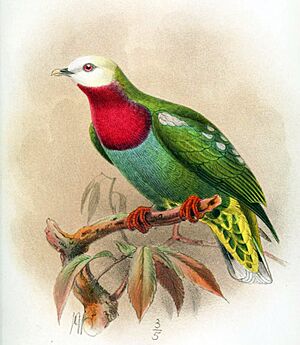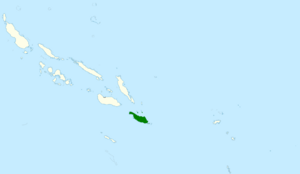White-headed fruit dove facts for kids
Quick facts for kids White-headed fruit dove |
|
|---|---|
 |
|
| An 1893 illustration of the species by John Gerrard Keulemans | |
| Conservation status | |
| Scientific classification | |
| Genus: |
Ptilinopus
|
| Species: |
eugeniae
|
 |
|
| Range of the white-headed fruit dove within the Solomon Islands | |
| Synonyms | |
|
|
The white-headed fruit dove (Ptilinopus eugeniae) is a type of bird. It belongs to the pigeon family called Columbidae. This bird was first described in 1856 by an English bird expert named John Gould. Its scientific name, eugeniae, honors a French empress named Eugénie de Montijo.
Adult white-headed fruit doves have a white head and a purplish-red patch on their chest. Their shoulders have a grey patch. The top parts of their body are olive-green, and their belly is greenish with a blue tint. The area under their tail is yellowish. Young doves have green heads, but their forehead and upper throat are white. Their grey shoulder patch is much smaller, and the red on their chest is only in the middle.
This bird lives only on the islands of Makira, Ugi, and Malaupaina in the Solomon Islands. It lives in forests in lowlands, hills, and ridges. It can also be found in nearby farm areas. It is very common in the lower parts of hills. These doves eat small fruits and berries.
The International Union for Conservation of Nature says this bird is "near-threatened." This means it might become endangered soon. Even though it can live in places changed by humans, it is still at risk. This is because of deforestation (cutting down trees) and losing its home.
Contents
About its Name and Family
The white-headed fruit dove was first called Iotreron eugeniae in 1856. This name was given by the English bird expert John Gould. He studied birds from the Solomon Islands. Later that same year, another English zoologist, George Robert Gray, moved it to the fruit dove group called Ptilinopus.
The name Ptilinopus comes from ancient Greek words. "Ptilon" means feather, and "pous" means foot. The specific name eugeniae is a tribute to Eugénie de Montijo. She was the wife of a French emperor, Napoleon III. The official common name for this bird is "white-headed fruit dove." Sometimes, people also call it "Eugenie's fruit dove."
The white-headed fruit dove is one of over 50 kinds of pigeons in the Ptilinopus group. These birds live across Southeast Asia and Oceania. This dove is most closely related to the claret-breasted fruit dove (Ptilinopus viridis). Scientists are still studying how these two birds are related.
Some experts think they might be the same species. Others see them as different species. The International Ornithologists' Union (IOU) currently says the white-headed fruit dove does not have any subspecies.
A study in 2014 looked at the DNA of these birds. It showed that the white-headed fruit dove is very close to the lewisii subspecies. This might mean that some subspecies should be moved to the white-headed fruit dove group. The study also found that the white-headed and claret-breasted fruit doves are closely related to the orange-bellied fruit dove.
This group of birds is then related to other fruit doves. These include the grey-headed, pink-spotted, Wallace's, orange-fronted, and ornate fruit doves. The Tanna fruit dove is the earliest bird to branch off in this group.
Here is a family tree showing how these fruit doves are related:
| tannensis group |
|
||||||||||||||||||||||||||||||||||||||||||||||||
What Does It Look Like?
The white-headed fruit dove is a small, round bird with a short tail. It is about 18 to 22 centimeters (7 to 9 inches) long. Its whole head and upper throat are bright white. The back of its neck is white with a light yellow tint.
Most of its upper body is olive green. Its neck, back, and shoulder feathers have a shiny copper look. Its wings are a darker green with a blue shine. The feathers under its wings are light grey, forming a clear patch on its shoulder. There are also small grey spots on some wing feathers.
Its chest is a rich purplish-red with a dark purple edge. The lower part of its body is a duller green, sometimes with a blue or grey tint. The area under its tail is pale yellow to white. The bird's beak is dull maroon at the base and yellow at the tip. Its legs are purplish-red with a blue tint. Its eyes are orange-red, and the skin around them is blue-grey to dark green.
Both male and female doves look similar. Young doves have green heads, but only their forehead and upper throat are white. Their grey shoulder patch is much smaller. The red on their chest is only in the middle. Young birds also have smaller grey spots on their wing feathers and greener underparts without a blue tint.
You might confuse this bird with the yellow-bibbed fruit dove. But male yellow-bibbed fruit doves have a bright yellow band on their chest. Female and young birds are more alike. However, they do not have the grey shoulder patch. Their under-tail area is also a brighter yellow.
The white-headed fruit dove is different from the claret-breasted fruit dove. It has a white head and upper throat. Its chest patch has a dark purple border. Its underparts are a duller green. You can also tell the white-headed fruit dove apart from other pigeons in its area. Its snowy-white head and red chest patch make it unique.
The call of this bird is a soft two-note sound: hu..whoOo. It makes this sound every 3 to 6 seconds. The first note is short and quiet. The second note is longer, about half a second, and stronger. Sometimes, it repeats this sound a few times.
Where Does It Live?
The white-headed fruit dove lives only in the Solomon Islands. You can find it on the islands of Makira, Ugi, and Malaupaina. It lives in forests in lowlands, hills, and ridges. It can also be found in nearby farm areas. It lives at heights up to 700 meters (2,300 feet).
It is especially common in the lower parts of hills. It might prefer forests in the hills. This bird can also live in places that humans have changed. A study in 2015 on Makira showed that it seemed to prefer areas changed by people. These included forests that grew back, gardens, and cocoa farms.
How Does It Live?
The white-headed fruit dove is usually seen alone or in pairs. Sometimes, small groups gather at large fruit trees. There, they might join other birds like the silver-capped fruit dove and chestnut-bellied imperial pigeon to find food.
This bird flies fast and straight. It often flies over open areas, where it is easier to see than in the forest. The white-headed fruit dove eats mostly fruit. It feeds on small-seeded fruits and berries. Sometimes, it eats from single trees away from the main forest. Not much is known about how this dove raises its young. However, a young dove was seen in September.
Is It in Danger?
The International Union for Conservation of Nature (IUCN) lists the white-headed fruit dove as "near-threatened." This is because it lives in a small area and its population is not very large. Also, logging (cutting down trees) is happening on the islands where it lives.
This bird is quite common in its home range, especially in the foothills. But its population is thought to be decreasing fairly quickly. Even though it seems to be able to live in areas changed by humans, deforestation and habitat loss are still big threats to it.


